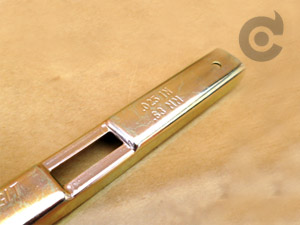Check filing angles, clean the bar and check depth guages. For .404 chain. Have a look at our sponsored chainsaw file test and also our video on manual chain sharpening
We have an essential info section looking at how to ID chains – why not take a look by clicking here.
Chains are not measured by stretching them out on a bench and squinting down a tape measure – chains are identified by PITCH, GUAGE and NUMBER OF DRIVE LINKS [no – not the cutting teeth – drive links and you’ll know the difference by even a cursory look at the chain ID link above].
Bars likewise are not measured the same way – manufacturers give them a set ‘length’ which is generally the sticky out bit that comes out of the chainsaw [not including the mount unless in the case of large double ended milling bars which are the exception to the rule and measured end to end].
If that all seems too much like hard work then bear in mind that chainsaws require a lot more attention and care than other power tools. Regard your chainsaw as ‘Excalibur’ with the cutting edge as your chain [please don’t refer to is as a ‘blade’ – it’s a chain. When you look to change it ask for a new ‘chain’ – not a new ‘blade’]. Identifying and being able to use the correct terms will set you apart from others.
Chain sharpening is key – if you cannot use a chain and have it cutting well until the cutters are so small they end up getting knocked off – you have plenty to learn. Watch, research, rinse and repeat. Read our article on chain sharpening by clicking here – often people get caught up in different angles and techniques – but the principles are always the same.
If you are serious about correct maintenance of your bar and chain work your way through the Oregon manual [click here] and after that check out the Stihl equivalent [click here]. Using a chainsaw for 20 years [badly] does not qualify you as an experienced user – so be the change, make the difference and keep educating yourself about these valuable yet dangerous tools.
And finally – why buy a new bar and chain without checking/replacing the drive rim or drive sprocket? [again click here if unsure on what these refer to]. Much as we would enjoy selling you the next bar and chain much earlier than you needed it [a worn sprocket will wear your new chain which will wear your new bar a lot lot faster] – we would rather you got the most out of your purchase.
Related products
-

Oregon Depth Guage tool 0.75mm[.030″] .404 Chains
Part Number 107488$12.026 reviewsStock 16Add to -

Oregon Depth Gauge tool 0.65mm[.025″] 1/4, 3/8 Lo Pro,.325, 3/8 Chains
Part Number 27530$9.832 reviewsStock 46Add to -

00008934008 FL3 Stihl Depth Gauge Tool .325 Chains
Part Number 00008934008$11.62Stock 30Add to -

00008934009 FL4 Stihl Depth Gauge Tool 3/8 Chains
Part Number 00008934009$11.62Stock 32Add to



































 text or whatsapp us
text or whatsapp us  orders@chainsawbars.co.uk
orders@chainsawbars.co.uk
 sign me up
sign me up basket
basket 
